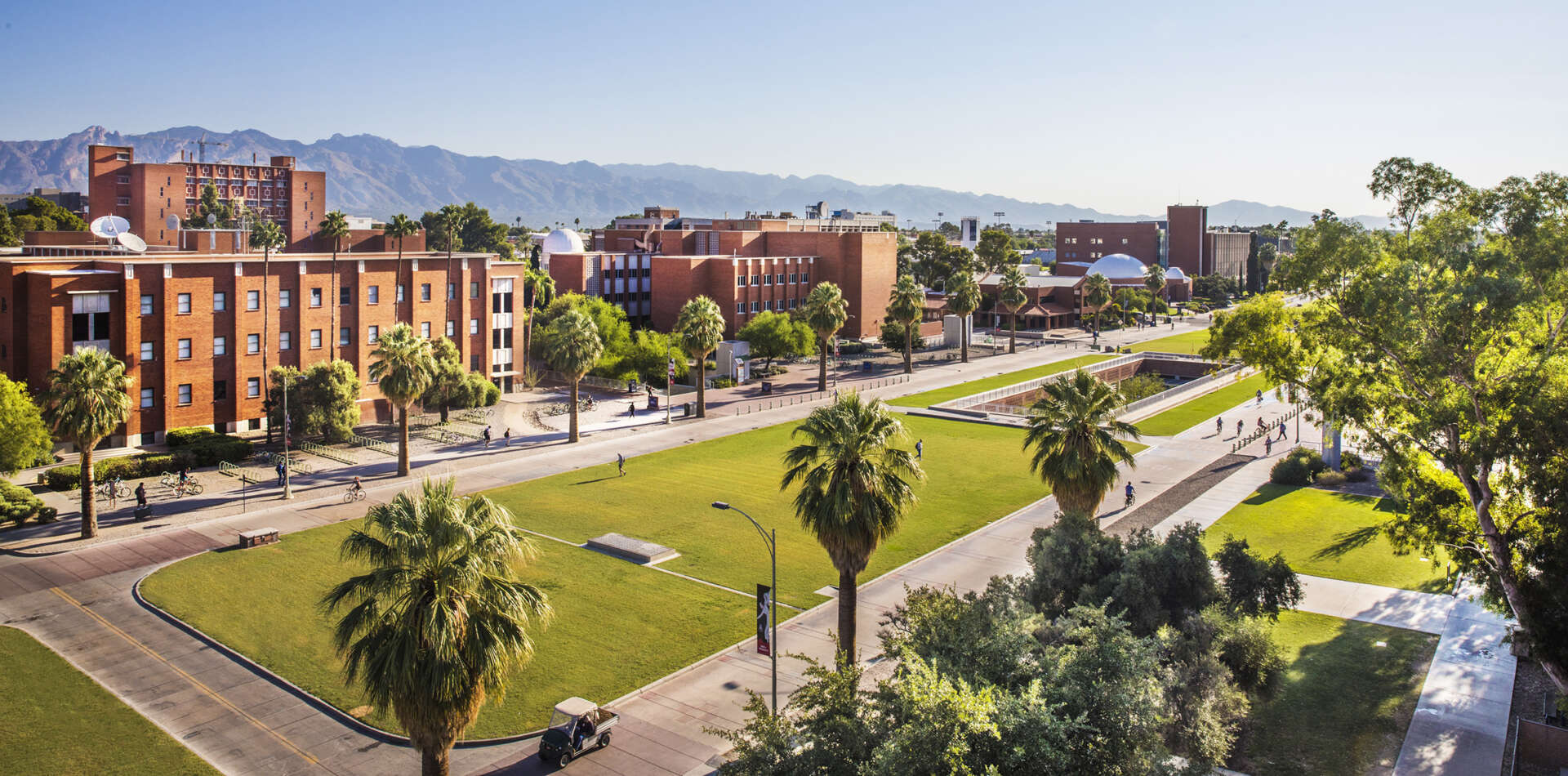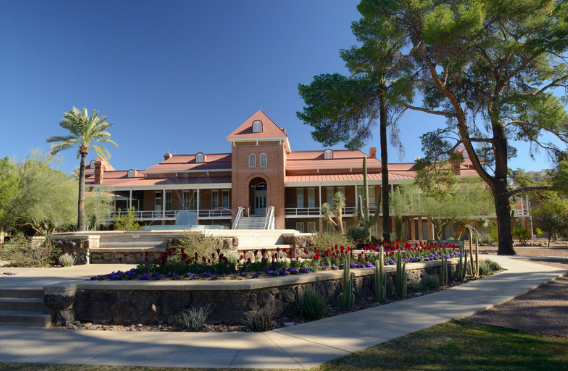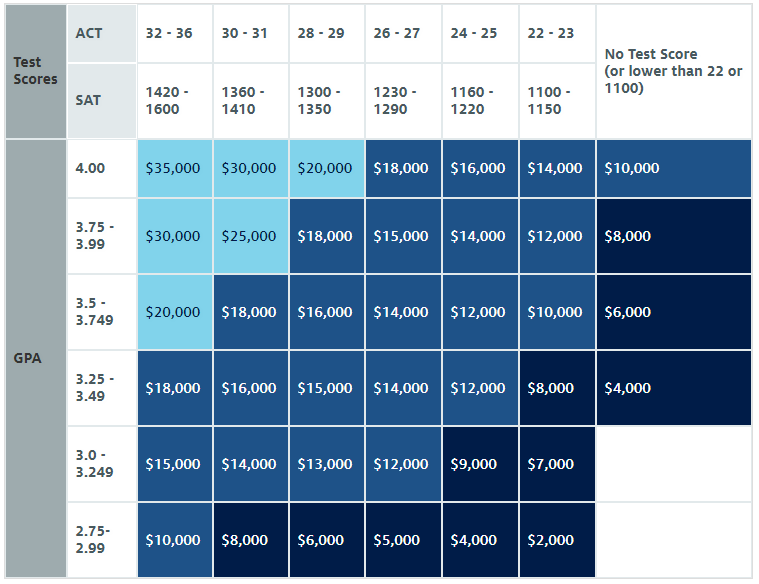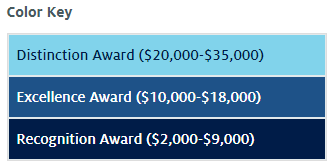
ASU’s Sun Devil Football Stadium in Tempe, Arizona.
Arizona State University (ASU) and the University of Arizona (UA) are both well-respected public universities located in the southwestern United States. Yet, there are several key differences between the two institutions that prospective undergraduate students should consider when making a decision about where to enroll.
Size: One of the major differences between ASU and UA is the size of their respective campuses. ASU is the largest public university in the country, with an in-person student body of over 77,000 students spread over several campuses throughout the Phoenix metropolitan area. In contrast, UA has a student body of around 44,000 students and is located in Tucson, Arizona. This difference in size can impact the overall campus culture, with ASU offering a more diverse and eclectic community, while UA offers a more intimate and close-knit campus experience. ASU also has tens of thousands of students completing programs online, whereas UA has only 7,500 online students.
Academic Program Overview: Both ASU and UA offer a wide range of undergraduate academic programs, but each has its own strengths and areas of focus. ASU is known for its programs in sustainability, business, and engineering, among others, while UA is particularly strong in areas such as science, medicine, and the arts. Prospective students should research each institution’s individual academic programs and departments to determine which one is the best fit for their academic interests and goals.
Degree Offerings: Both ASU and UA offer a wide range of undergraduate majors, covering a variety of disciplines including arts and humanities, business, education, engineering, health sciences, and social sciences. At ASU, students can choose from over 250 undergraduate majors, while at UA, students can choose from over 300 majors. Both universities also offer a variety of interdisciplinary programs and opportunities for students to design their own majors.
Research Opportunities: Both ASU and UA offer students the opportunity to engage in undergraduate research, providing them with hands-on experience in their field of study. At ASU, the Undergraduate Research Opportunities Program (UROP) provides students with funding and support to conduct research projects in a variety of disciplines. At UA, the Undergraduate Research Opportunities Consortium (UROC) provides similar opportunities for students to engage in research projects, including funding and mentorship from faculty.
Internships and Co-Op Programs: Both ASU and UA offer students the opportunity to participate in internships and co-op programs, providing them with real-world experience in their field of study. At ASU, the Career and Professional Development Services office provides students with access to a variety of internship and co-op opportunities, both on- and off-campus. At UA, the Career Services office provides similar resources and opportunities for students to gain hands-on experience in their field.
Faculty and Resources: Both ASU and UA offer students access to a talented and dedicated faculty, as well as a range of resources and facilities to support their academic and professional goals. At ASU, students have access to state-of-the-art facilities and resources, including the Biodesign Institute, the Walter Cronkite School of Journalism and Mass Communication, and the Herberger Institute for Design and the Arts. At UA, students have access to a similar range of facilities and resources, including the Biosphere 2 research facility, the School of Journalism, and the Fred Fox School of Music.
Undergraduate Honors Programs: Arizona State University (ASU) and the University of Arizona (UA) both offer undergraduate honors programs for high-achieving students. These programs provide students with a more rigorous and challenging academic experience, as well as a variety of opportunities for research, community engagement, and leadership development. In this comparison, we will explore the similarities and differences between the honors programs at ASU and UA.
- Curriculum: Both ASU and UA offer honors programs that are designed to challenge students with rigorous coursework, research opportunities, and hands-on learning experiences. At ASU, the Barrett Honors College offers students access to a variety of honors courses, as well as research and leadership opportunities. Students in the Barrett Honors College are also required to complete a capstone project, which can take the form of a thesis, research project, or community engagement project. At UA, the Honors College offers a similar curriculum, with a focus on interdisciplinary coursework, research, and community engagement. Students in the Honors College at UA are also required to complete a capstone project.
- Community: Both ASU and UA offer honors programs that are designed to create a close-knit community of high-achieving students. At ASU, the Barrett Honors College offers students the opportunity to live in dedicated honors housing, participate in honors-only events and activities, and connect with a network of alumni and community leaders. At UA, the Honors College offers similar opportunities for students to connect with their peers and engage in community activities.
- Facilities: Both ASU and UA offer honors programs that are housed in dedicated facilities on their respective campuses. At ASU, the Barrett Honors College is located in the heart of the Tempe campus and provides students with access to dedicated study spaces, meeting rooms, and lounges. At UA, the Honors College is housed in the Student Union building, providing students with access to a variety of resources, including advising services, tutoring, and study spaces.
- Support Services: Both ASU and UA offer honors programs that provide students with a variety of support services to help them succeed academically and professionally. At ASU, the Barrett Honors College offers students access to a dedicated team of advisors, tutors, and career services professionals. At UA, the Honors College offers similar support services, including advising, tutoring, and career services.
Campus Highlights:

Arizona State University campus.
Arizona State University:

ASU from above.
- Memorial Union: The Memorial Union is the heart of the ASU campus and a popular gathering place for students. It features a variety of dining options, study spaces, and recreational facilities, including a bowling alley and movie theater.
- The Hayden Lawn: The Hayden Lawn is a large, open green space on the ASU campus, perfect for picnics, studying, or just relaxing in the sun. It is also the site of many campus events and festivals throughout the year.
- The Sun Devil Fitness Complex: The Sun Devil Fitness Complex is a state-of-the-art facility that offers a wide range of exercise and recreation options, including cardio equipment, weight rooms, indoor tracks, and more.
- The Art Museum: The ASU Art Museum is a world-class facility that features exhibitions of contemporary and modern art, as well as a variety of educational programs and events.
University of Arizona:

A nice view of the University of Arizona’s Tucson campus.

Tucson, Arizona is home to UA
- The UA Mall: The UA Mall is the heart of the UA campus and a popular gathering place for students. It is a large open green space that is surrounded by many of the university’s most iconic buildings.
- Student Union Memorial Center (SUMC): The SUMC is a large student center that features a variety of dining options, study spaces, and recreational facilities, including a game room and movie theater.
- Arizona Stadium: Arizona Stadium is the home of the UA football team and a popular gathering place for students on game days. It offers a variety of seating options, including student sections and VIP suites.
- Biosphere 2: Biosphere 2 is a research facility located on the UA campus that is dedicated to exploring and understanding the world’s ecosystems. It is open to the public and offers a variety of educational programs and events.
Student Life: Another key difference between ASU and UA is their respective campus cultures and student life experiences. ASU is known for its vibrant student life, with over 500 student organizations, a thriving Greek community, and a robust intramural sports program. UA also offers a rich student life, with a variety of clubs and organizations, as well as a strong Greek community and athletic programs. However, the campus culture at UA is often described as being more laid-back and outdoorsy, while ASU is known for its bustling and energetic atmosphere.
Athletics: Both ASU and UA have successful athletic programs and a strong tradition of school spirit. ASU is a member of the Pac-12 Conference and fields teams in 19 varsity sports, including football, basketball, baseball, and golf. The ASU Sun Devils have won multiple conference championships and have a strong following among students, alumni, and fans. UA is also a member of the Pac-12 Conference and fields teams in 21 varsity sports, including football, basketball, baseball, and soccer. The UA Wildcats are known for their fierce competitiveness and have a dedicated fan base that supports the teams.
School Spirit: When it comes to school spirit, both ASU and UA have a proud and passionate student body that supports their respective athletic programs. ASU is known for its energetic and enthusiastic student section, the “Sun Devil Student Section,” which is a staple at home games for all sports. UA also has a strong student section, the “ZonaZoo,” that is known for its vocal support and passion for Wildcat athletics. Both institutions host a variety of events and activities throughout the year that bring students and alumni together to show their support for the teams and their school.
Sports Facilities: The athletic facilities at both ASU and UA are first-rate and provide excellent resources and support for student-athletes. ASU has a variety of state-of-the-art facilities, including Sun Devil Stadium, Wells Fargo Arena, and the Mona Plummer Aquatic Center. UA also boasts top-notch athletic facilities, including Arizona Stadium, McKale Center, and the Hillenbrand Aquatic Center. In addition, both universities have recently invested in upgrades and renovations to their facilities, ensuring that students have access to the latest and greatest resources and technology.
Intramural Sports: In addition to their varsity sports programs, both ASU and UA offer a variety of intramural sports options for students who are looking to stay active and engaged. These programs allow students to participate in a variety of recreational activities, from traditional sports like flag football and basketball, to more unconventional options like rock climbing and ultimate frisbee. These programs provide students with a fun and social outlet for physical activity, and can be a great way to get involved and make new friends.
Cost and Financial Aid: Finally, prospective students should consider the cost and financial aid opportunities available at each institution. Both ASU and UA are public universities, so they are typically more affordable than private institutions. However, the cost of attendance and the availability of financial aid can vary depending on the specific program and individual circumstances. Prospective students should research each institution’s tuition and fees, as well as the availability of scholarships, grants, and other forms of financial aid.
Location: The location of each university is another factor to consider. ASU is located in the heart of the Phoenix metropolitan area, which is known for its year-round sunny weather, vibrant arts and culture scene, and thriving tech industry. UA is located in Tucson, which is a smaller city known for its natural beauty, outdoor recreation opportunities, and laid-back atmosphere. Prospective students should consider their personal preferences and priorities when it comes to location, and weigh the benefits of living in a bustling urban center versus a smaller, more relaxed college town.
- Phoenix vs. Tucson Geography: Phoenix is located in the central part of Arizona and is the state’s largest city. It covers a vast area of over 500 square miles and is surrounded by mountains, deserts, and other natural attractions. Tucson, on the other hand, is located in the southeastern part of the state and is surrounded by the Sonoran Desert. The city is known for its natural beauty, including the nearby Saguaro National Park, which is home to the iconic Saguaro cactus.
- Phoenix vs. Tucson Climate: The climate in Phoenix is characterized by hot summers and mild winters, with temperatures often exceeding 100°F during the summer months. On the other hand, the climate in Tucson is characterized by warm winters and hot summers, with temperatures typically ranging from the high 70s to low 90s. Both cities receive low amounts of rainfall, with Phoenix receiving around 8 inches of rain per year and Tucson receiving around 12 inches.
- Phoenix vs. Tucson Population: Phoenix is the fifth-largest city in the United States, with a population of over 1.7 million people. The city is known for its diverse population and strong economic growth. Tucson, on the other hand, has a population of around 535,000 and is known for its unique blend of Native American, Mexican, and Spanish cultures.
- Phoenix vs. Tucson Economy: Phoenix is a hub for commerce and industry, with a thriving economy that is driven by industries such as tourism, healthcare, and technology. The city is home to several major corporations, including Intel and GoDaddy, and is known for its business-friendly environment. Tucson has a smaller, more diversified economy, with industries such as education, manufacturing, and healthcare playing a significant role. The city is home to several major employers, including the University of Arizona and Raytheon Technologies.
- Phoenix vs. Tucson Culture: Both Phoenix and Tucson have a rich cultural heritage, with a blend of Native American, Mexican, and Spanish influences. Phoenix is known for its contemporary art scene, with a variety of museums and galleries showcasing local and international talent. The city is also home to several major events and festivals, including the Phoenix Film Festival and the Phoenix Comicon. Tucson is known for its unique blend of Native American, Mexican, and Spanish cultures, and is home to several cultural institutions, including the Tucson Museum of Art and the Tucson Folk Festival.
- Phoenix vs. Tucson Lifestyle: The lifestyle in Phoenix is characterized by a strong focus on outdoor activities and recreation, with ample opportunities for hiking, biking, and exploring the nearby deserts and mountains. The city is also known for its vibrant nightlife, with a variety of bars, clubs, and restaurants. Tucson has a more laid-back, relaxed lifestyle, with a strong emphasis on outdoor recreation and cultural activities. The city is home to several parks and natural attractions, including Saguaro National Park, and is known for its vibrant food scene, with a variety of locally-owned restaurants and food trucks.
Overall, both ASU and UA offer unique and valuable undergraduate experiences for students, and the best choice for an individual student will depend on their individual goals, interests, and priorities. Prospective students should research both institutions in detail, attend campus tours and information sessions, and talk to current students and alumni to get a sense of the campus culture and academic programs. With careful consideration and research, prospective students can find the right university for them and take the first step towards achieving their academic and personal goals.

Old Main Building at University of Arizona.
 When high school students apply to the University of Arizona for the 2022-23 academic year, SAT and/or ACT scores will not be required for admission
When high school students apply to the University of Arizona for the 2022-23 academic year, SAT and/or ACT scores will not be required for admission 
